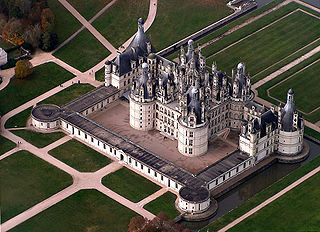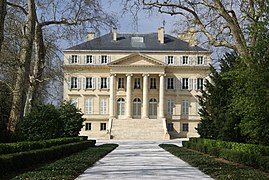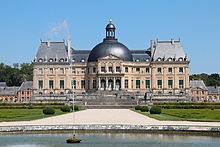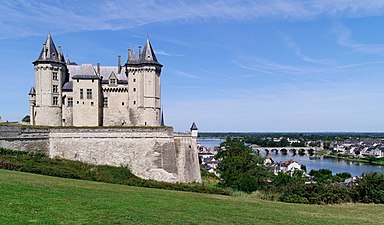
The Palace of Versailles is a former royal residence commissioned by King Louis XIV located in Versailles, about 18 kilometres (11 mi) west of Paris, France.

Maine-et-Loire is a department in the Loire Valley in the Pays de la Loire region in Western France. It is named after the two rivers, Maine and the Loire. It borders Mayenne and Sarthe to the north, Loire-Atlantique to the west, Indre-et-Loire to the east, Vienne and Deux-Sèvres to the south, Vendée to the south-west, and Ille-et-Vilaine to the north-west. It also borders Ille-et-Vilaine in the north for just 20 yards (19 m), France's shortest department boundary. Its prefecture is Angers; its subprefectures are Cholet, Saumur and Segré-en-Anjou Bleu. Maine-et-Loire had a population of 818,273 in 2019.

The Loire Valley, spanning 280 kilometres (170 mi), is a valley located in the middle stretch of the Loire river in central France, in both the administrative regions Pays de la Loire and Centre-Val de Loire. The area of the Loire Valley comprises about 800 square kilometres (310 sq mi). It is referred to as the Cradle of the French and the Garden of France due to the abundance of vineyards, fruit orchards, and artichoke, and asparagus fields, which line the banks of the river. Notable for its historic towns, architecture, and wines, the valley has been inhabited since the Middle Palaeolithic period. In 2000, UNESCO added the central part of the Loire River valley to its list of World Heritage Sites.

The Château d'Amboise is a château in Amboise, located in the Indre-et-Loire département of the Loire Valley in France. Confiscated by the monarchy in the 15th century, it became a favoured royal residence and was extensively rebuilt. King Charles VIII died at the château in 1498 after hitting his head on a door lintel. The château fell into decline from the second half of the 16th century and the majority of the interior buildings were later demolished, but some survived and have been restored, along with the outer defensive circuit of towers and walls. It has been recognised as a monument historique by the French Ministry of Culture since 1840.

The Château de Chenonceau is a French château spanning the river Cher, near the small village of Chenonceaux, Indre-et-Loire, Centre-Val de Loire. It is one of the best-known châteaux of the Loire Valley.

The Château de Montsoreau is a Flamboyant Gothic castle in the Loire Valley, directly built in the Loire riverbed. It is located in the market town of Montsoreau, in the Maine-et-Loire département of France, close to Saumur, Chinon, Fontevraud-l'Abbaye, and Candes-Saint-Martin. The Château de Montsoreau is situated at the confluence of two rivers, the Loire and the Vienne, and the meeting point of three historical regions: Anjou, Poitou, and Touraine. It is the only château of the Loire Valley built directly in the Loire riverbed.

The Château de Chambord in Chambord, Centre-Val de Loire, France, is one of the most recognisable châteaux in the world because of its very distinctive French Renaissance architecture, which blends traditional French medieval forms with classical Renaissance structures. The building was constructed by the king of France, Francis I.

Tourism in France directly contributed 79.8 billion euros to gross domestic product (GDP) in 2013, 30% of which comes from international visitors and 70% from domestic tourism spending. The total contribution of travel and tourism represents 9.7% of GDP and supports 2.9 million jobs in the country. Tourism contributes significantly to the balance of payments.

Pays de la Loire is one of the eighteen regions of France, located on the country's Atlantic coast. It was created in the 1950s to serve as a zone of influence for its capital and most populated city, Nantes, one of a handful of French "balancing metropolises". In 2020, Pays de la Loire had a population of 3,832,120.

Azay-le-Rideau is a commune in the Indre-et-Loire department in the Centre-Val de Loire region in central-west France.

The châteaux of the Loire Valley are part of the architectural heritage of the historic towns of Amboise, Angers, Blois, Chinon, Montsoreau, Orléans, Saumur, and Tours along the river Loire in France. They illustrate Renaissance ideals of design in France.

17th-century French art is generally referred to as Baroque, but from the mid- to late 17th century, the style of French art shows a classical adherence to certain rules of proportion and sobriety uncharacteristic of the Baroque as it was practiced in most of the rest of Europe during the same period.

Montsoreau is a commune of the Loire Valley in the Maine-et-Loire department in western France on the Loire, 160 km (99 mi) from the Atlantic coast and 250 km (160 mi) from Paris. The village is listed among The Most Beautiful Villages of France and is part of the Loire Valley UNESCO World Heritage Site.

French Renaissance architecture is a style which was prominent between the late 15th and early 17th centuries in the Kingdom of France. It succeeded French Gothic architecture. The style was originally imported from Italy after the Hundred Years' War by the French kings Charles VII, Louis XI, Charles VIII, Louis XII and François I. Several notable royal châteaux in this style were built in the Loire Valley, notably the Château de Montsoreau, the Château de Langeais, the Château d'Amboise, the Château de Blois, the Château de Gaillon and the Château de Chambord, as well as, closer to Paris, the Château de Fontainebleau.

Château de Chinon is a château located on the bank of the river Vienne in Chinon, France. It was founded by Theobald I, Count of Blois. In the 11th century the castle became the property of the counts of Anjou. In 1156 Henry II of England, a member of the House of Anjou, took the castle from his brother Geoffrey, Count of Nantes, after Geoffrey rebelled for a second time. Henry favoured the Château de Chinon as a residence. Most of the standing structure can be attributed to his reign; he died there in 1189.

The Loire is the longest river in France and the 171st longest in the world. With a length of 1,006 kilometres (625 mi), it drains 117,054 km2 (45,195 sq mi), more than a fifth of France's land, while its average discharge is only half that of the Rhône.

Le goût Rothschild describes a detailed, elaborate style of interior decoration and living which had its origin in France, Britain, Austria, and Germany during the nineteenth century, when the rich, famous, and powerful Rothschild family was at its height. The Rothschild aesthetic and life-style later influenced other rich and powerful families, including the Astors, Vanderbilts and Rockefellers, and became hallmarks of the American Gilded Age. Aspects of le goût Rothschild continued into the twentieth century, affecting such designers as Yves Saint Laurent and Robert Denning.

The Château de Montsoreau-Museum Contemporary Art is a private museum open to the public in Montsoreau, France. It opened 8 April 2016. The permanent collection exhibited at Château de Montsoreau consists of Philippe Méaille's collection of works by the conceptual art collective Art & Language.

The Montsoreau Flea Market is the largest flea market in the Loire Valley, taking place all year the second Sunday of the month. Montsoreau is a small city named after the mount Soreau on which is built the famous château de Montsoreau, the only château of the Loire Valley to have been built in the Loire riverbed. Montsoreau is listed among the most beautiful villages of France, and both the village and the château are part of the UNESCO listed World Heritage Site of the Loire valley. The Montsoreau Flea Market includes all year, a hundred professional merchants and is located in the vieux port district, on the banks of the Loire river.

The Château du Jonchet is a French Renaissance château located on the banks of the Aigre River in the former commune of Romilly-sur-Aigre in the Eure-et-Loir department in the region of Centre-Val de Loire, in northern France.










































